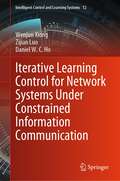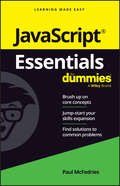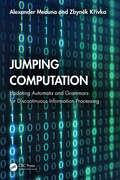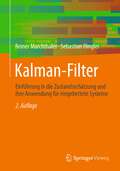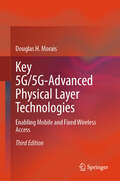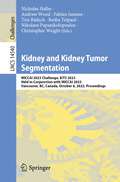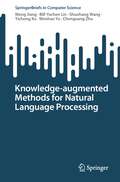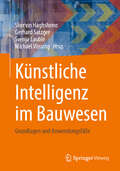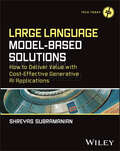- Table View
- List View
The IT Support Handbook: A How-To Guide to Providing Effective Help and Support to IT Users
by Mike HalseyBecome a more effective tech professional by learning how to provide the most useful IT support for your users. You'll learn how to efficiently and effectively deal with any type of problem, including operating systems, software, and hardware. IT support is often complex, time-consuming, and expensive, but it doesn't have to be with the right processes in place. Whether you're an individual, part of an IT support team, or managing staff supporting PC users in their homes, this book will help you understand the right way to approach, troubleshoot, and isolate problems so they can be handled efficiently, with the least disruption and cost to your business. Expanded and revised for this second edition, you'll make yourself popular with your colleagues, and keep your clients and users happy and productive. New To This Edition The world of work has changed, with remote and hybrid working now the new normal and with IT Support departments worldwide having to adapt to this new paradigm. This expanded edition highlights the skills, tools, and structures needed to support businesses of any size in the new normal. What You'll Learn Manage reporting, and keep a record of issues that occur Provide effective remote support for users working from home or elsewhere in the world Use error and system reporting in Windows to obtain high-quality, relevant information Spot patterns in user behavior that may be causing difficult-to-diagnose problems Be familiar with best practices to make you a better support professional Who This Book Is For IT professionals, IT support (on-site and remote), and system administrators who manage support teams. No prior knowledge is required.
Iterative Learning Control for Network Systems Under Constrained Information Communication (Intelligent Control and Learning Systems #12)
by Wenjun Xiong Zijian Luo Daniel W. HoThis book focuses on the subject area of Network Systems and Control Theory, providing a comprehensive examination of the dynamic behavior of networked systems operating under communication constraints. It introduces innovative iterative learning control strategies that aim to ensure stability, consistency, and security of networked systems. The field of networked systems has garnered significant interest from scientists and engineers across various disciplines, including information, electrical, transportation, life, social, and management sciences. This book consistently addresses a wide range of issues related to networked systems, emphasizing the critical impact of communication constraints on stability and security. It highlights the effectiveness and importance of iterative learning methods in tackling these challenges.Suitable for both undergraduate and graduate students interested in networked systems and iterative learning control, this book alsoserves as a valuable resource for university faculty and engineers engaged in complex systems, control theory research, and real-world applications. Its broad appeal extends to professionals working in related fields, seeking a deeper understanding of networked systems and their control mechanisms.
Iterative Learning Control over Random Fading Channels
by Dong Shen Xinghuo YuRandom fading communication is a type of attenuation damage of data over certain propagation media. Establishing a systematic framework for the design and analysis of learning control schemes, the book studies in depth the iterative learning control for stochastic systems with random fading communication. The authors introduce both cases where the statistics of the random fading channels are known in advance and unknown. They then extend the framework to other systems, including multi-agent systems, point-to-point tracking systems, and multi-sensor systems. More importantly, a learning control scheme is established to solve the multi-objective tracking problem with faded measurements, which can help practical applications of learning control for high-precision tracking of networked systems. The book will be of interest to researchers and engineers interested in learning control, data-driven control, and networked control systems.
Iterative Learning Control over Random Fading Channels
by Dong Shen Xinghuo YuRandom fading communication is a type of attenuation damage of data over certain propagation media. Establishing a systematic framework for the design and analysis of learning control schemes, the book studies in depth the iterative learning control for stochastic systems with random fading communication. The authors introduce both cases where the statistics of the random fading channels are known in advance and unknown. They then extend the framework to other systems, including multi-agent systems, point-to-point tracking systems, and multi-sensor systems. More importantly, a learning control scheme is established to solve the multi-objective tracking problem with faded measurements, which can help practical applications of learning control for high-precision tracking of networked systems. The book will be of interest to researchers and engineers interested in learning control, data-driven control, and networked control systems.
It's All Analytics, Part III: The Applications of AI, Analytics, and Data Science
by Scott Burk Gary MinerProfessionals are challenged each day by a changing landscape of technology and terminology. In recent history, especially the last 25 years, there has been an explosion of terms and methods born that automate and improve decision-making and operations. One term, called "analytics," is an overarching description of a compilation of methodologies. But artificial intelligence (AI), statistics, decision science, and optimization, which have been around for decades, have resurged. Also, things like business intelligence, online analytical processing (OLAP) and many, many more have been born or reborn. How is someone to make sense of all this methodology, terminology? Extending on the foundations introduced in the first book, this book illustrates how professionals in healthcare, business, and government are applying these disciplines, methods, and technologies. The goal of this book is to get leaders and practitioners to start thinking about how they may deploy techniques outside their function or industry into their domain. Application of modern technology into new areas is one of the fastest, most effective ways to improve results. By providing a rich set of examples, this book fosters creativity in the application and use of AI and analytics in innovative ways.
It's All Analytics, Part III: The Applications of AI, Analytics, and Data Science
by Scott Burk Gary MinerProfessionals are challenged each day by a changing landscape of technology and terminology. In recent history, especially the last 25 years, there has been an explosion of terms and methods born that automate and improve decision-making and operations. One term, called "analytics," is an overarching description of a compilation of methodologies. But artificial intelligence (AI), statistics, decision science, and optimization, which have been around for decades, have resurged. Also, things like business intelligence, online analytical processing (OLAP) and many, many more have been born or reborn. How is someone to make sense of all this methodology, terminology? Extending on the foundations introduced in the first book, this book illustrates how professionals in healthcare, business, and government are applying these disciplines, methods, and technologies. The goal of this book is to get leaders and practitioners to start thinking about how they may deploy techniques outside their function or industry into their domain. Application of modern technology into new areas is one of the fastest, most effective ways to improve results. By providing a rich set of examples, this book fosters creativity in the application and use of AI and analytics in innovative ways.
Java Coding Problems: Become an expert Java programmer by solving over 250 brand-new, modern, real-world problems
by Anghel LeonardStay on top of the new Java features (up to JDK 21) and find efficient solutions for your programming woes. With over 250 problems and solutions, you'll learn new ways to deal with real-world coding tasks and answers to common interview questions. Purchase of the print or Kindle book includes a free PDF eBookKey FeaturesSolve Java programming challenges and get interview-ready with the power of modern Java 21Test your Java skills using language features, algorithms, data structures, and design patternsExplore tons of examples, all fully refreshed for this edition, meant to help you accommodate JDK 12 to JDK 21Book DescriptionThe super-fast evolution of the JDK between versions 12 and 21 has made the learning curve of modern Java steeper, and increased the time needed to learn it. This book will make your learning journey quicker and increase your willingness to try Java’s new features by explaining the correct practices and decisions related to complexity, performance, readability, and more. Java Coding Problems takes you through Java’s latest features but doesn’t always advocate the use of new solutions — instead, it focuses on revealing the trade-offs involved in deciding what the best solution is for a certain problem. There are more than two hundred brand new and carefully selected problems in this second edition, chosen to highlight and cover the core everyday challenges of a Java programmer. Apart from providing a comprehensive compendium of problem solutions based on real-world examples, this book will also give you the confidence to answer questions relating to matching particular streams and methods to various problems. By the end of this book you will have gained a strong understanding of Java’s new features and have the confidence to develop and choose the right solutions to your problems.What you will learnAdopt the latest JDK 21 features in your applicationsExplore Records, Record Patterns, Record serialization and so onWork with Sealed Classes and Interfaces for increasing encapsulationLearn how to exploit Context-Specific Deserialization FiltersSolve problems relating to collections and esoteric data structuresLearn advanced techniques for extending the Java functional APIExplore the brand-new Socket API and Simple Web ServerTackle modern Garbage Collectors and Dynamic CDS ArchivesWho this book is forIf you are a Java developer who wants to level-up by solving real-world problems, then this book is for you. Working knowledge of the Java programming language is required to get the most out of this book
Java für Teetrinker: Ein funktionaler Zugang zur Programmierung mit Java
by Sven Eric PanitzEs ist an der Zeit Java didaktisch neu zu denken. Seit der ersten offiziellen Vorstellung von Java 1995 ist viel passiert. Ursprünglich war Java konsequent als eine rein objektorientierte Sprache definiert. Über die Jahre wurde die Sprache weiterentwickelt und ist alles andere als kalter Kaffee. Lambda-Ausdrücke, Datenhaltungsklassen, Pattern-Matching oder Datenströme ermöglichen es, neben dem objektorientierten Programmierparadigma von Anfang an das funktionale Programmierparadigma in der Lehre anzuwenden. Dieses Lehrbuch verfolgt konsequent den Weg, auch die aktuelleren Konstrukte von Java einzubeziehen und damit einen dem heutigen Stand der Technik passenden Kurs anzubieten, der allen wichtigen Programmierparadigmen gerecht wird und auf die Softwareentwicklung in unterschiedlichen Programmiersprachen vorbereitet. Dabei werden die wichtigsten Datenstrukturen und Klassiker der Informatik als Beispiele verwendet. So begegnen uns Mengen in Form von Suchbäumen genauso wie durch Hashwerte organisiert. Es werden Klassiker wie der Chatbot „Eliza“ oder die Simulation „Game of Life“ implementiert. Die Alpha-Beta-Suche für den besten Spielzug eines Strategiespiels und kleine visuelle Spiele im zweidimensionalen Raum sind vertreten, wie die Generierung von Code für den Datenbank- und Web-Zugriff auf Objekte. Zu guter Letzt wird für eine eigene kleine Programmiersprache Assembler-Code generiert. So entsteht ein Programmierkurs, der sich von Anfang an der Struktur und Interpretation von Programmen widmet.
JavaScript Essentials For Dummies
by Paul McFedriesThe concise and digestible get-started guide to JavaScript programming JavaScript Essentials For Dummies is your quick reference to all the core concepts about JavaScript—the dynamic scripting language that is often the final step in creating powerful websites. This no-nonsense book gets right to the point, eliminating review material, wordy explanations, and fluff. Find out all you need to know about the foundations of JavaScript, swiftly and crystal clear. Perfect for a brush-up on the basics or as an everyday desk reference on the job, this is the reliable little book you can always turn to for answers. Get a quick and thorough intro to the basic concepts of coding with JavaScript Review what you've already learned or pick up essential new skills Add interactive features to websites with JavaScript programming Keep this concise reference book handy for jogging your memory as you work This book is to the point, focusing on the key topics you need to know about this popular programming language. Great for supplementing classroom learning, reviewing for a certification, or staying knowledgeable on the job.
JavaScript Essentials For Dummies
by Paul McFedriesThe concise and digestible get-started guide to JavaScript programming JavaScript Essentials For Dummies is your quick reference to all the core concepts about JavaScript—the dynamic scripting language that is often the final step in creating powerful websites. This no-nonsense book gets right to the point, eliminating review material, wordy explanations, and fluff. Find out all you need to know about the foundations of JavaScript, swiftly and crystal clear. Perfect for a brush-up on the basics or as an everyday desk reference on the job, this is the reliable little book you can always turn to for answers. Get a quick and thorough intro to the basic concepts of coding with JavaScript Review what you've already learned or pick up essential new skills Add interactive features to websites with JavaScript programming Keep this concise reference book handy for jogging your memory as you work This book is to the point, focusing on the key topics you need to know about this popular programming language. Great for supplementing classroom learning, reviewing for a certification, or staying knowledgeable on the job.
Jump-start Your SOC Analyst Career: A Roadmap to Cybersecurity Success
by Tyler Wall Jarrett RodrickThe frontlines of cybersecurity operations include many unfilled jobs and exciting career opportunities.A transition to a security operations center (SOC) analyst position could be the start of a new path for you. Learn to actively analyze threats, protect your enterprise from harm, and kick-start your road to cybersecurity success with this one-of-a-kind book. Authors Tyler E. Wall and Jarrett W. Rodrick carefully and expertly share real-world insights and practical tips in Jump-start Your SOC Analyst Career. The lessons revealed equip you for interview preparation, tackling day one on the job, and setting long-term development goals.This book highlights personal stories from five SOC professionals at various career levels with keen advice that is immediately applicable to your own journey. The gems of knowledge shared in this book provide you with a notable advantage for entering this dynamic field of work. The recent surplus in demand for SOC analysts makes Jump-start Your SOC Analyst Career a must-have for aspiring tech professionals and long-time veterans alike. Recent industry developments such as using the cloud and security automation are broken down in concise,understandable ways, to name a few. The rapidly changing world of cybersecurity requires innovation and fresh eyes, and this book is your roadmap to success. New to this edition: This revised edition includes three entirely new chapters: Roadmap to Cybersecurity Success, The SOC Analyst Method, and ChatGPT for SOC Analysts. In addition, new material includes a substantially revised Cloud chapter, revised pre-requisite skills, and minor revisions to all chapters to update data. What You Will Learn • Understand the demand for SOC analysts • Know how to find a SOC analyst job fast • Be aware of the people you will interact with as a SOC analyst • Be clear on the prerequisite skills needed to be a SOC analyst and what to study • Be familiar with the day-to-day life of a SOC analyst, including the tools and language used • Discover the rapidly emerging areas of a SOC analyst job: the cloud and security automation • Explore the career paths of a SOC analyst • Discover background-specific tips for your roadmap to cybersecurity success • Know how to analyze a security event • Know how to apply ChatGPT as a SOC analyst Who This Book Is For Anyone interested in starting a career in cybersecurity: recent graduates, IT professionals transitioning into security, veterans, and those who are self-taught.
Jumping Computation: Updating Automata and Grammars for Discontinuous Information Processing
by Alexander Meduna Zbyněk KřivkaJumping Computation: Updating Automata and Grammars for Discontinuous Information Processing is primarily a theoretically oriented treatment of jumping automata and grammars, covering all essential theoretical topics concerning them, including their power, properties, and transformations. From a practical viewpoint, it describes various concepts, methods, algorithms, techniques, case studies and applications based upon these automata and grammars. In today’s computerized world, the scientific development and study of computation, referred to as the theory of computation, plays a crucial role. One important branch, language theory, investigates how to define and study languages and their models, which formalize algorithms according to which their computation is executed. These language-defining models are classified into two basic categories: automata, which define languages by recognizing their words, and grammars, which generate them. Introduced many decades ago, these rules reflect classical sequential computation. However, today’s computational methods frequently process information in a fundamentally different way, frequently “jumping” over large portions of the information as a whole. This book adapts classical models to formalize and study this kind of computation properly. Simply put, during their language-defining process, these adapted versions, called jumping automata and grammars, jump across the words they work on. The book selects important models and summarizes key results about them in a compact and uniform way. It relates each model to a particular form of modern computation, such as sequential, semi-parallel and totally parallel computation, and explains how the model in question properly reflects and formalizes the corresponding form of computation, thus allowing us to obtain a systematized body of mathematically precise knowledge concerning the jumping computation. The book pays a special attention to power, closure properties, and transformations, and also describes many algorithms that modify jumping grammars and automata so they satisfy some prescribed properties without changing the defined language. The book will be of great interest to anyone researching the theory of computation across the fields of computer science, mathematics, engineering, logic and linguistics.
Jumping Computation: Updating Automata and Grammars for Discontinuous Information Processing
by Alexander Meduna Zbyněk KřivkaJumping Computation: Updating Automata and Grammars for Discontinuous Information Processing is primarily a theoretically oriented treatment of jumping automata and grammars, covering all essential theoretical topics concerning them, including their power, properties, and transformations. From a practical viewpoint, it describes various concepts, methods, algorithms, techniques, case studies and applications based upon these automata and grammars. In today’s computerized world, the scientific development and study of computation, referred to as the theory of computation, plays a crucial role. One important branch, language theory, investigates how to define and study languages and their models, which formalize algorithms according to which their computation is executed. These language-defining models are classified into two basic categories: automata, which define languages by recognizing their words, and grammars, which generate them. Introduced many decades ago, these rules reflect classical sequential computation. However, today’s computational methods frequently process information in a fundamentally different way, frequently “jumping” over large portions of the information as a whole. This book adapts classical models to formalize and study this kind of computation properly. Simply put, during their language-defining process, these adapted versions, called jumping automata and grammars, jump across the words they work on. The book selects important models and summarizes key results about them in a compact and uniform way. It relates each model to a particular form of modern computation, such as sequential, semi-parallel and totally parallel computation, and explains how the model in question properly reflects and formalizes the corresponding form of computation, thus allowing us to obtain a systematized body of mathematically precise knowledge concerning the jumping computation. The book pays a special attention to power, closure properties, and transformations, and also describes many algorithms that modify jumping grammars and automata so they satisfy some prescribed properties without changing the defined language. The book will be of great interest to anyone researching the theory of computation across the fields of computer science, mathematics, engineering, logic and linguistics.
Kalman-Filter: Einführung in die Zustandsschätzung und ihre Anwendung für eingebettete Systeme
by Reiner Marchthaler Sebastian DinglerDieses Lehrbuch befasst sich leicht verständlich mit der Theorie der Kalman-Filterung. Die Autoren geben damit eine Einführung in Kalman-Filter und deren Anwendung für eingebettete Systeme. Zusätzlich wird anhand konkreter Praxisbeispiele der Kalman-Filterentwurf demonstriert – Teilschritte werden im Buch ausführlich erläutert.Kalman-Filter sind die erste Wahl, um Störsignale auf den Sensorsignalen zu eliminieren. Dies ist von besonderer Bedeutung, da viele technische Systeme ihre prozessrelevanten Informationen über Sensoren gewinnen. Jeder Messwert eines Sensors weißt jedoch aufgrund verschiedener Ursachen einen Messfehler auf. Würde ein System nur auf Basis dieser ungenauen Sensorinformationen arbeiten, so wären viele Anwendungen, wie zum Beispiel ein Navigationssystem oder autonome arbeitende Systeme, nicht möglich.Das Buch ist geeignet für interessierte Bachelor- und Master-Studierende der Fachrichtungen Informatik, Maschinenbau, Elektrotechnik undMechatronik. Ebenso ist das Buch eine Hilfe für Ingenieure und Wissenschaftler, die ein Kalman-Filter z. B. für die Datenfusion oder die Schätzung unbekannter Größen in Echtzeitanwendungen einsetzen möchten.
Kantian Ethics and the Attention Economy: Duty and Distraction
by Timothy Aylsworth Clinton CastroIn this open access book, Timothy Aylsworth and Clinton Castro draw on the deep well of Kantian ethics to argue that we have moral duties, both to ourselves and to others, to protect our autonomy from the threat posed by the problematic use of technology. The problematic use of technologies like smartphones threatens our autonomy in a variety of ways, and critics have only begun to appreciate the vast scope of this problem. In the last decade, we have seen a flurry of books making “self-help” arguments about how we could live happier, more fulfilling lives if we were less addicted to our phones. But none of these authors see this issue as one involving a moral duty to protect our autonomy.
Key 5G/5G-Advanced Physical Layer Technologies: Enabling Mobile and Fixed Wireless Access
by Douglas H. MoraisThis third edition of this text covers the key technologies associated with the physical transmission of data on 5G mobile systems. Following an updated overview of these technologies, the author provides a high-level description of 3GPP’s mobile communications standard (5G/5G-Advanced) and shows how the key technologies presented earlier facilitate the transmission of very high-speed user data and control data and can provide very low latency for use cases where this is important. In the final chapter, an updated overview and the physical layer aspects of 5G NR enabled Fixed Wireless Access (FWA) networks is presented. Material in the second edition addressed mainly the key physical layer technologies and features associated with 3GPP Release 15, the first release to support 5G, and Release 16. This edition adds descriptions of some of the technological advancements supported in Releases 17 and 18, the latter being designated by 3GPP as 5G-Advanced. In addition to numerous enhancements of existing features, these releases include new features such as support for 1024-QAM in the downlink in the FR1 band, Reduced Capability (RedCAP) devices, Network Controlled repeaters, operation in the 6 GHz band and above 52.6 GHz, support for broadcast/multicast services, and Non-terrestrial Networks (NTNs). Additionally, a look ahead at some of the planned features and enhancements of Release 19 is provided. This textbook is intended for graduate and upper undergraduate engineering students and practicing engineers and technicians who have an interest in 3GPP’s 5G enabled mobile and or FWA networks and want to acquire, where missing, the necessary technology background in order to understand 3GPP’s physical layer specifications and operation. Provided are working problems and helpful examples throughout the text.
KI als Zukunftsmotor für Verlage: Potenziale und Fallbeispiele für KI-Anwendungen in der Buchbranche
by Okke SchlüterGenerative KI ist ein Game Changer für Verlage. Wie aber sollten Verlage darauf reagieren? Da in der Publishing-Branche Daten eine wichtige Rolle spielen, können KI-Technologien auch hier wertvolle Beiträge leisten. Diese Innovationen sichern gleichzeitig die Zukunft der Verlagsbranche gegenüber globalen Tech-Konzernen ab, die selbst Publishing anbieten. Ziel des Bandes ist es daher, über konkrete Potenziale in Verlagen zu sprechen, seien es z. B. Manuskriptarbeit, Marketingkommunikation oder Nachauflagen. Mit einer Einführung in KI, drei konkreten Fallbeispielen und einer Potenzialanalyse zu ChatGPT.
Kidney and Kidney Tumor Segmentation: MICCAI 2023 Challenge, KiTS 2023, Held in Conjunction with MICCAI 2023, Vancouver, BC, Canada, October 8, 2023, Proceedings (Lecture Notes in Computer Science #14540)
by Nicholas Heller Andrew Wood Fabian Isensee Tim Rädsch Resha Teipaul Nikolaos Papanikolopoulos Christopher WeightThis book constitutes the Third International Challenge on Kidney and Kidney Tumor Segmentation, KiTS 2023, which was held in conjunction with the 26th International Conference on Medical Image Computing and Computer-Assisted Intervention, MICCAI 2023. The challenge took place in Vancouver, BC, Canada, on October 8, 2023. The 22 contributions presented in this book were carefully reviewed and selected from 29 submissions. This challenge aims to develop the best system for automatic semantic segmentation of kidneys, renal tumors and renal cysts.
Knowledge-augmented Methods for Natural Language Processing (SpringerBriefs in Computer Science)
by Meng Jiang Bill Yuchen Lin Shuohang Wang Yichong Xu Wenhao Yu Chenguang ZhuOver the last few years, natural language processing has seen remarkable progress due to the emergence of larger-scale models, better training techniques, and greater availability of data. Examples of these advancements include GPT-4, ChatGPT, and other pre-trained language models. These models are capable of characterizing linguistic patterns and generating context-aware representations, resulting in high-quality output. However, these models rely solely on input-output pairs during training and, therefore, struggle to incorporate external world knowledge, such as named entities, their relations, common sense, and domain-specific content. Incorporating knowledge into the training and inference of language models is critical to their ability to represent language accurately. Additionally, knowledge is essential in achieving higher levels of intelligence that cannot be attained through statistical learning of input text patterns alone. In this book, we will review recent developmentsin the field of natural language processing, specifically focusing on the role of knowledge in language representation. We will examine how pre-trained language models like GPT-4 and ChatGPT are limited in their ability to capture external world knowledge and explore various approaches to incorporate knowledge into language models. Additionally, we will discuss the significance of knowledge in enabling higher levels of intelligence that go beyond statistical learning on input text patterns. Overall, this survey aims to provide insights into the importance of knowledge in natural language processing and highlight recent advances in this field.
Knowledge Management in Organisations: 18th International Conference, KMO 2024, Kaohsiung, Taiwan, July 29 – August 1, 2024, Proceedings (Communications in Computer and Information Science #2152)
by Lorna Uden I-Hsien TingThis book constitutes the proceedings of the 18th International Conference on Knowledge management in Organizations, KMO 2024, which took place in Kaohsiung, Taiwan, during July 29–August 1, 2024 The 33 full papers were carefully reviewed and selected from 72 submissions. The papers are organized in subject areas as follows: Knowledge Transfer and Sharing; Knowledge in Business and Organisation; Innovation and Knowledge Creation; KM and Education; KM Process and Model; Information and Knowledge Management Systems; AI, IT and New Trends in KM; and Healthcare.
Kontaktverfolgung in der Post-Covid-Welt: Ein kryptologischer Ansatz
by Mridul Nandi Subhamoy Maitra Pranab Chakraborty Suprita TalnikarDieses Buch diskutiert modernste Techniken im Bereich der Contact-Tracing-Anwendungen. Dieses in der Medizin gut bekannte Thema hat aufgrund der COVID-19-Pandemie Aufmerksamkeit von Regierungen, verschiedenen Industrien und der akademischen Welt erhalten. Das Buch stellt eine Verbindung zwischen neuen Vorschlägen zu Contact-Tracing-Anwendungen und einer Kontext-Literaturübersicht hauptsächlich aus kryptologischer Sicht her. Da diese Anwendungen die Sicherheit und Privatsphäre von Personen betreffen, ist ihre Analyse aus kryptologischer Sicht von höchster Bedeutung. Daher werden die aktuellen Entwicklungen der weltweiten Vorschläge, einschließlich Singapur, Europa, USA, Australien und Indien, diskutiert. Durch eine eingehende Untersuchung der Designprinzipien jedes Protokolls ist dieses Buch für Forscher, Studierende und Fachleute gleichermaßen wertvoll.
Künstliche Intelligenz im Bauwesen: Grundlagen und Anwendungsfälle
by Shervin Haghsheno Gerhard Satzger Svenja Lauble Michael VössingDieses Fachbuch demonstriert das Potenzial Künstlicher Intelligenz (KI) im Bauwesen. Die rasant wachsende Menge an Daten sowie die in Bauprojekten eingesetzte Hard- und Software bilden die Grundlage für projektübergreifende und vorausschauende Analysen, die u.a. durch Ansätze des maschinellen Lernens und der Robotik ermöglicht werden.Die einzelnen Beiträge dieses Buches geben einen allgemeinen Überblick über Methoden der Künstlichen Intelligenz (KI) und veranschaulichen deren Einsatz im Bauwesen anhand konkreter Anwendungsfälle aus Forschung und Praxis. KI-Methoden versprechen hier sowohl Effizienzgewinne und Fehlerreduzierung durch Automatisierung repetitiver Tätigkeiten als auch völlig neue Möglichkeiten der Entscheidungsunterstützung in Bauplanung, -ausführung und -betrieb. Die Publikation richtet sich insbesondere an Führungskräfte und Fachexperten der Bauwirtschaft, die mit KI-Methoden eine nachhaltige Verbesserung ihrer Unternehmensprozesse erreichen wollen.
The Language of Deception: Weaponizing Next Generation AI
by Justin HutchensA penetrating look at the dark side of emerging AI technologies In The Language of Deception: Weaponizing Next Generation AI, artificial intelligence and cybersecurity veteran Justin Hutchens delivers an incisive and penetrating look at how contemporary and future AI can and will be weaponized for malicious and adversarial purposes. In the book, you will explore multiple foundational concepts to include the history of social engineering and social robotics, the psychology of deception, considerations of machine sentience and consciousness, and the history of how technology has been weaponized in the past. From these foundations, the author examines topics related to the emerging risks of advanced AI technologies, to include: The use of Large Language Models (LLMs) for social manipulation, disinformation, psychological operations, deception and fraud The implementation of LLMs to construct fully autonomous social engineering systems for targeted attacks or for mass manipulation at scale The technical use of LLMs and the underlying transformer architecture for use in technical weapons systems to include advanced next-generation malware, physical robotics, and even autonomous munition systems Speculative future risks such as the alignment problem, disembodiment attacks, and flash wars.Perfect for tech enthusiasts, cybersecurity specialists, and AI and machine learning professionals, The Language of Deception is an insightful and timely take on an increasingly essential subject.
The Language of Deception: Weaponizing Next Generation AI
by Justin HutchensA penetrating look at the dark side of emerging AI technologies In The Language of Deception: Weaponizing Next Generation AI, artificial intelligence and cybersecurity veteran Justin Hutchens delivers an incisive and penetrating look at how contemporary and future AI can and will be weaponized for malicious and adversarial purposes. In the book, you will explore multiple foundational concepts to include the history of social engineering and social robotics, the psychology of deception, considerations of machine sentience and consciousness, and the history of how technology has been weaponized in the past. From these foundations, the author examines topics related to the emerging risks of advanced AI technologies, to include: The use of Large Language Models (LLMs) for social manipulation, disinformation, psychological operations, deception and fraud The implementation of LLMs to construct fully autonomous social engineering systems for targeted attacks or for mass manipulation at scale The technical use of LLMs and the underlying transformer architecture for use in technical weapons systems to include advanced next-generation malware, physical robotics, and even autonomous munition systems Speculative future risks such as the alignment problem, disembodiment attacks, and flash wars.Perfect for tech enthusiasts, cybersecurity specialists, and AI and machine learning professionals, The Language of Deception is an insightful and timely take on an increasingly essential subject.
Large Language Model-Based Solutions: How to Deliver Value with Cost-Effective Generative AI Applications (Tech Today)
by Shreyas SubramanianLearn to build cost-effective apps using Large Language Models In Large Language Model-Based Solutions: How to Deliver Value with Cost-Effective Generative AI Applications, Principal Data Scientist at Amazon Web Services, Shreyas Subramanian, delivers a practical guide for developers and data scientists who wish to build and deploy cost-effective large language model (LLM)-based solutions. In the book, you'll find coverage of a wide range of key topics, including how to select a model, pre- and post-processing of data, prompt engineering, and instruction fine tuning. The author sheds light on techniques for optimizing inference, like model quantization and pruning, as well as different and affordable architectures for typical generative AI (GenAI) applications, including search systems, agent assists, and autonomous agents. You'll also find: Effective strategies to address the challenge of the high computational cost associated with LLMs Assistance with the complexities of building and deploying affordable generative AI apps, including tuning and inference techniques Selection criteria for choosing a model, with particular consideration given to compact, nimble, and domain-specific models Perfect for developers and data scientists interested in deploying foundational models, or business leaders planning to scale out their use of GenAI, Large Language Model-Based Solutions will also benefit project leaders and managers, technical support staff, and administrators with an interest or stake in the subject.

